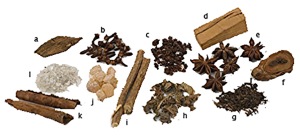Japanese Incense | Ingredients Explained
|
You have invested your time and money in tracking down some fine incense products. More than that ... you're going to light them and use them to relax, enhance your life, increase concentration, meditate, create a positive atmosphere around your home ... there are many reasons why burning or 'listening' to incense is a good thing!
 | Quality ingredients are key to Japanese incense.
If all this is important, interesting and valuable to you, then you want to be assured about the types of ingredients used in the Japanese incense sticks we sell and promote at Vectis Karma. Japanese incense benefits are known worldwide, due to the finest natural materials it is made of: roots, barks, flowers and fruits... |
| |
| |
What ingredients are used in Japanese incense?
Roots & Barks
a. ALOESWOOD/AGARWOOD - the resinous wood of the Aquilaria tree, treasured for its complex and pleasing aroma
k. CINNAMON - the dried, curled up bark of a Sri Lankan evergreen tree, one of the world's oldest and best known spices
d. SANDALWOOD - the woody core ingredient of fragrance and medicine products for millennia, cultivated from the Santalum trees of India, Indonesia and South Pacific
Also (not shown): HAISOKOH - thin, hairlike root from China Also and KANSHO - rhizome of an Indian plant
| |
Resins
i. BORNEOL CAMPHOR - a mint-scented aromatic produced by the Camphor laurel tree, used for centuries in incense, medicine and cooking j. FRANKINCENSE - the resinous 'tears' of the Arabian Boswellia tree, historically one of the world's most heavily traded treasures
c. MYRRH - the resin of the Commiphora Myrrha tree of Yemen and North America, used in incense, Ayurvedic remedies and wine Also (not shown): BENZOIN - a resin from Java and Thailand
| |
Aromatic Plants
h. PATCHOULI - a tropical herb of the mint family, highly recognisable for its warm, woodsy and playfyl scent f. RHUBARB - an herbaceous, perennial plant with a tart red stalk, often used in cooking and Chinese medicine as well as an aromatic ingredient
g. TEA LEAVES - enjoyed as a beverage for thousands of years, the warm, soothing character of tea leaves is also used as a fragrance
| |
Fruits & Flowers
b. CLOVE - a dried flower bud originated from the Spice Islands of India, well known for its warm, sweet aroma e. STAR ANISE - the dried fruit of the Japanese Star Anise tree, inedible but possessing a lively, unique and sweet scent useful for incense
| |
|
|